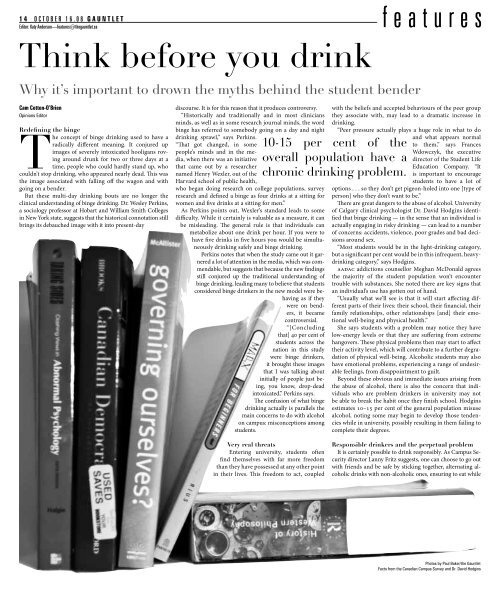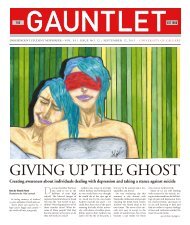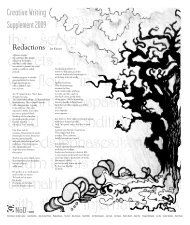Create successful ePaper yourself
Turn your PDF publications into a flip-book with our unique Google optimized e-Paper software.
features<br />
14 OCTOBER 16.08 GAUNTLET<br />
Editor: Katy Anderson—features@thegauntlet.ca<br />
Think before you drink<br />
Why it’s important to drown the myths behind the student bender<br />
Cam Cotton-O’Brien<br />
Opinions Editor<br />
Redefining the binge<br />
<strong>The</strong> concept of binge drinking used to have a<br />
radically different meaning. It conjured up<br />
images of severely intoxicated hooligans roving<br />
around drunk for two or three days at a<br />
time, people who could hardly stand up, who<br />
couldn’t stop drinking, who appeared nearly dead. This was<br />
the image associated with falling off the wagon and with<br />
going on a bender.<br />
But these multi-day drinking bouts are no longer the<br />
clinical understanding of binge drinking. Dr. Wesley Perkins,<br />
a sociology professor at Hobart and William Smith Colleges<br />
in New York state, suggests that the historical connotation still<br />
brings its debauched image with it into present-day<br />
discourse. It is for this reason that it produces controversy.<br />
“Historically and traditionally and in most clinicians<br />
minds, as well as in some research journal minds, the word<br />
binge has referred to somebody going on a day and night<br />
drinking sprawl,” says Perkins.<br />
“That got changed, in some<br />
people’s minds and in the media,<br />
when there was an initiative<br />
that came out by a researcher<br />
named Henry Wexler, out of the<br />
Harvard school of public health,<br />
who began doing research on college populations, survey<br />
research and defined a binge as four drinks at a sitting for<br />
women and five drinks at a sitting for men.”<br />
As Perkins points out, Wexler’s standard leads to some<br />
difficulty. While it certainly is valuable as a measure, it can<br />
be misleading. <strong>The</strong> general rule is that individuals can<br />
metabolize about one drink per hour. If you were to<br />
have five drinks in five hours you would be simultaneously<br />
drinking safely and binge drinking.<br />
Perkins notes that when the study came out it garnered<br />
a lot of attention in the media, which was commendable,<br />
but suggests that because the new findings<br />
still conjured up the traditional understanding of<br />
binge drinking, leading many to believe that students<br />
considered binge drinkers in the new model were behaving<br />
as if they<br />
were on benders,<br />
it became<br />
controversial.<br />
“[Concluding<br />
that] 40 per cent of<br />
students across the<br />
nation in this study<br />
were binge drinkers,<br />
it brought these images<br />
that I was talking about<br />
initially of people just being,<br />
you know, drop-dead<br />
intoxicated,” Perkins says.<br />
<strong>The</strong> confusion of what binge<br />
drinking actually is parallels the<br />
main concerns to do with alcohol<br />
on campus: misconceptions among<br />
students.<br />
with the beliefs and accepted behaviours of the peer group<br />
they associate with, may lead to a dramatic increase in<br />
drinking.<br />
“Peer pressure actually plays a huge role in what to do<br />
10-15 per cent of the<br />
overall population have a<br />
chronic drinking problem.<br />
and what appears normal<br />
to them,” says Frances<br />
Wdowczyk, the executive<br />
director of the Student Life<br />
Education Company. “It<br />
is important to encourage<br />
students to have a lot of<br />
options . . . so they don’t get pigeon-holed into one [type of<br />
person] who they don’t want to be.”<br />
<strong>The</strong>re are great dangers to the abuse of alcohol. University<br />
of Calgary clinical psychologist Dr. David Hodgins identified<br />
that binge drinking — in the sense that an individual is<br />
actually engaging in risky drinking — can lead to a number<br />
of concerns: accidents, violence, poor grades and bad decisions<br />
around sex.<br />
“Most students would be in the light-drinking category,<br />
but a significant per cent would be in this infrequent, heavydrinking<br />
category,” says Hodgins.<br />
AADAC addictions counsellor Meghan McDonald agrees<br />
the majority of the student population won’t encounter<br />
trouble with substances. She noted there are key signs that<br />
an individual’s use has gotten out of hand.<br />
“Usually what we’ll see is that it will start affecting different<br />
parts of their lives: their school, their financial, their<br />
family relationships, other relationships [and] their emotional<br />
well-being and physical health.”<br />
She says students with a problem may notice they have<br />
low-energy levels or that they are suffering from extreme<br />
hangovers. <strong>The</strong>se physical problems then may start to affect<br />
their activity level, which will contribute to a further degradation<br />
of physical well-being. Alcoholic students may also<br />
have emotional problems, experiencing a range of undesirable<br />
feelings, from disappointment to guilt.<br />
Beyond these obvious and immediate issues arising from<br />
the abuse of alcohol, there is also the concern that individuals<br />
who are problem drinkers in university may not<br />
be able to break the habit once they finish school. Hodgins<br />
estimates 10–15 per cent of the general population misuse<br />
alcohol, noting some may begin to develop those tendencies<br />
while in university, possibly resulting in them failing to<br />
complete their degrees.<br />
Very real threats<br />
Entering university, students often<br />
find themselves with far more freedom<br />
than they have possessed at any other point<br />
in their lives. This freedom to act, coupled<br />
Responsible drinkers and the perpetual problem<br />
It is certainly possible to drink responsibly. As Campus Security<br />
director Lanny Fritz suggests, one can choose to go out<br />
with friends and be safe by sticking together, alternating alcoholic<br />
drinks with non-alcoholic ones, ensuring to eat while<br />
Photos by Paul Baker/the <strong>Gauntlet</strong><br />
Facts from the Canadian Campus Survey and Dr. David Hodgins

















